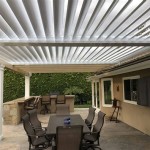Easy Patio Building Ideas
Creating a patio can significantly enhance outdoor living spaces, offering a designated area for relaxation, entertainment, and enjoying the natural surroundings. The process of patio construction need not be overly complex or expensive. This article explores various easy patio building ideas, focusing on simplified methods and readily available materials to create functional and aesthetically pleasing outdoor spaces.
Gravel Patio Construction
Gravel patios represent a cost-effective and straightforward option for establishing an outdoor living area. The installation process is relatively simple and requires minimal specialized tools. This makes it a particularly attractive choice for do-it-yourself enthusiasts and those seeking budget-friendly solutions.
The initial step involves defining the patio area. Using marking paint or stakes and string, the desired dimensions of the patio should be clearly outlined. This ensures consistent sizing and prevents unnecessary material waste.
Following the marking process, excavation is required. A depth of approximately 4-6 inches should be removed from the designated area. This depth will accommodate the gravel base and ensure proper drainage. Removing topsoil is essential as it contains organic matter that can decompose and create an unstable base over time.
After excavation, a layer of landscape fabric should be laid down. This fabric serves as a weed barrier, preventing unwanted plant growth from emerging through the gravel. The fabric should extend slightly beyond the edges of the excavated area to provide comprehensive coverage.
Crushed stone, also known as road base, should then be laid over the landscape fabric. This layer provides a stable foundation for the gravel and facilitates drainage. The crushed stone should be compacted using a plate compactor to ensure a solid and level surface. The compaction process is vital; inadequate compaction can lead to shifting and unevenness in the gravel.
Finally, the desired gravel type can be spread over the crushed stone layer. Pea gravel, decomposed granite, or crushed gravel are all suitable options. The gravel should be evenly distributed to a depth of 2-3 inches. Routine raking will help maintain a neat and uniform appearance.
Optional edging can be installed around the perimeter of the gravel patio. Edging materials such as plastic edging, metal edging, or even larger stones can help contain the gravel and prevent it from spreading into adjacent areas. This adds a visual boundary and helps to maintain the patio's intended shape.
Paver Patio Installation
Paver patios offer a more refined aesthetic and increased durability compared to gravel options. While the installation process is slightly more involved, it remains manageable for DIY projects, particularly with careful planning and preparation. The result is a durable and visually appealing outdoor space that can significantly enhance property value.
Similar to gravel patios, defining the area is the first crucial step. The intended dimensions of the paver patio must be accurately marked using stakes and string. This ensures that the materials needed are correctly calculated and that the final product fits seamlessly within the landscape.
Excavation is then necessary to create space for the paver base. A depth of approximately 6-8 inches should be removed from the marked area. This depth accounts for the base materials and the pavers themselves. Ensuring a consistent depth is crucial for creating a level patio surface.
A layer of compacted gravel should be installed at the base of the excavation. This gravel base serves as the primary foundation for the pavers and provides essential drainage. The gravel should be thoroughly compacted using a plate compactor. Compact the gravel in layers, if possible, to achieve maximum density.
A layer of bedding sand is then spread over the compacted gravel. This layer provides a level surface for the pavers to rest on. The sand should be screeded to create a smooth and consistent depth of approximately 1 inch. Use a screed board or a long, straight object to level the sand.
Pavers are then carefully laid on top of the sand bed. The chosen paver pattern should be considered during the layout process. Standard patterns include running bond, herringbone, and basketweave. Maintain consistent spacing between pavers using paver spacers. These small plastic tools ensure uniform joints.
Once the pavers are laid, they should be compacted using a plate compactor with a rubber mat attachment. The rubber mat protects the pavers from damage during the compaction process. This step ensures that the pavers are firmly seated in the sand bed.
Polymeric sand should be swept into the joints between the pavers. Polymeric sand hardens when wetted, creating a durable and weed-resistant joint. Follow the manufacturer's instructions for applying and activating the polymeric sand. It is important to avoid leaving polymeric sand on the surface of the pavers before wetting.
Decking Tile Patio
Decking tiles offer a modular and adaptable solution for creating patios, particularly on existing concrete surfaces or balconies. These tiles are typically made from wood, composite materials, or plastic and are designed to interlock or connect easily. This method is ideal for renters or those looking for a less permanent patio solution.
Before installing decking tiles, ensure the existing surface is clean and level. Any debris, dirt, or loose materials should be removed. Minor imperfections can be addressed with leveling shims or self-leveling compound. A clean and level surface is critical for a stable and long-lasting deck tile patio.
Decking tiles are typically designed with interlocking edges or a grid system that allows for easy connection. Begin laying the tiles in one corner of the patio area, working outward. The tiles should be firmly pressed together to ensure a secure connection. Follow manufacturer's instructions for specific connection methods.
When necessary, decking tiles can be cut to fit around obstacles or to fill in irregular spaces. Use a saw or utility knife to make accurate cuts. Wear appropriate safety gear such as gloves and eye protection when cutting tiles.
Edging can be installed around the perimeter of the tile patio to create a finished look and prevent movement. Edging options include plastic edging, wood trim, or metal edging. Secure the edging to the existing surface or to the tiles themselves.
While decking tiles are generally low-maintenance, regular cleaning can help prolong their lifespan and maintain their appearance. Sweep or vacuum the tiles regularly to remove dirt and debris. Use a mild soap and water solution to clean the tiles as needed.
Decking tiles can be easily rearranged or removed, making them a flexible option for temporary patios or for those who like to change their outdoor décor. The modular nature of the tiles allows for customization and easy adaptation to changing needs.
Considerations for Patio Building
Regardless of the chosen patio building method, several key considerations should be addressed to ensure a successful project. Proper drainage is essential to prevent water accumulation and damage to the patio structure. This can be achieved through proper grading, the use of permeable materials, and the installation of drainage systems if necessary. Planning for drainage is crucial for the longevity of the patio.
The intended use of the patio should also be considered during the design phase. A patio intended for dining will require more space than a patio intended solely for relaxation. Furniture placement and traffic flow should be considered to create a functional and comfortable space. Consider the placement of grills, seating, and other outdoor amenities when planning the patio layout.
Local building codes and regulations should be consulted before beginning any patio construction project. Some municipalities require permits for patios exceeding a certain size or for patios that alter the existing drainage patterns. Obtaining the necessary permits can prevent costly fines and delays.
The aesthetic of the patio should complement the surrounding landscape and the style of the home. The choice of materials, colors, and patterns should be carefully considered to create a cohesive and visually appealing outdoor space. Consider the existing landscaping and architectural style of the home when choosing patio materials and design.
Finally, budget considerations are crucial. The cost of materials and labor can vary widely depending on the chosen method and the size of the patio. Creating a detailed budget and sticking to it can help prevent overspending and ensure a successful project. Obtain multiple quotes from suppliers and contractors to ensure competitive pricing.

14 Outdoor Patio Diy Ideas To Spruce Up Your Space

Diy Patio Ideas For Any Backyard

Diy Patio Ideas For Any Backyard

14 Outdoor Patio Diy Ideas To Spruce Up Your Space

Diy Patio Area With Lamp Posts Small Backyard Makeover Ideas

How To Build A Simple Diy Deck On Budget The Home Depot

20 Inspiring Backyard Makeovers Jenna Sue Design

58 Beautiful Outdoor Patio Design Decor Ideas A Piece Of Rainbow

Diy Stone Circle Patio Design Able Plan Mypatiodesign Com

20 Amazing Backyard Ideas On A Budget Diy Patio
Related Posts








